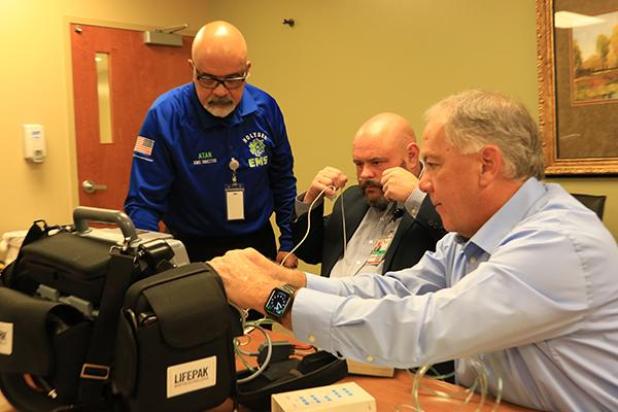
Andrew Turck | The Holyoke Enterprise Medical personnel set up a Lifepak 15 monitor and defibrillator at Melissa Memorial Hospital to demonstrate the process of capnography, which has the potential to revolutionize patient treatment. Pictured from the left are Melissa Memorial’s Interim Emergency Services Director Juan Atan and its CEO Michael Hassell, along with EMS Instructor Don Giullette out of Winter Haven, Florida.
MAKING WAVEFORMS
To introduce a process that may revolutionize patient care, Melissa Memorial Hospital CEO Michael Hassell placed a lightweight tube – called a nasal cannula – around his head and into his nose, plugged the device into a Lifepak 15 monitor and defibrillator, and…
The Lifepak’s digital screen remained unchanged; something was not registering within the machine. Observing the lack of readout in the hospital’s conference room, Emergency Medical Services Instructor Don Giullette frowned, but then took the setback in stride.
“Let me go back to the room and get [another] one,” he said.
Now assisted by Interim EMS Director Juan Atan, the three set up a new Lifepak and Hassell reinserted the cannula. At the bottom of the machine’s readout, a yellow line sprung to life.
The line, explained Giullette, indicates a patient’s carbon dioxide reading – in other words, the pressure this gas produces within the blood. For healthy patients, their blood normally would register between 35 to 45 millimeters of mercury, units of measurement used by hospitals to detect pressure.
Anomalies shown by this line, Hassell added, can indicate whether a medical facility should release a patient or keep them for further monitoring, using the phrase “sick-not sick.” Of particular note is the carbon dioxide methodology’s potential to detect sepsis, among other ailments.
Data from the Sepsis Alliance, which operates nationwide, show 1.7 million Americans are diagnosed with sepsis annually; of that amount, 270,000 die, a rate of more than 15 percent. Sepsis, the Alliance states, is the No. 1 cause of hospitalization readmissions, with 19 percent of people with the illness sent back to their hospitals within 30 days. The costs associated with these readmissions equal more than $3.5 billion per year.
When the CEO spoke, his carbon dioxide reading – formerly appearing like a series of buttes upon a landscape – morphed into what appeared to be a jagged ridge.
“He’s talking right now, so it’s jabbering up, some,” Giullette said. The line reverted to its former pattern. “The patient has to be quiet or just be out, so you get a good waveform like that. That’s a nice, good waveform.”
With these readouts, Giullette of Winter Haven, Florida, has been teaching health care professionals on the use of capnography – or the monitoring of carbon dioxide within the body – through his lecture and online course, “Capnography Capstone.” Melissa Memorial, he continued, is the first hospital to bring him to its facility for the course. One aspect that brought him to Hassell’s attention is he used to train the CEO in emergency services. For Melissa Memorial, Hassell noted, he provided the training for free, while being sure to sample local restaurants.
Giullette brings three decades of experience in emergency training. As of 2014, he holds a U.S. patent for an emergency ventilation apparatus design, system and method. His capnography training builds upon 15 years of research.
“I couldn’t tell the enthusiasm during the class, but I got the enthusiasm after the class,” he said. “They asked questions, they got more involved, they were thanking me for the course.”
When he traveled to the Chase County Community Hospital in Imperial, Nebraska, Giullette continued, the reception proved similarly positive: The nursing staff told him, regarding one of the doctors, “This blew him away and we will be using capnography on our patients.”
This methodology, Giullette said, has become a passion of his because of “how much was out there that I didn’t know and we didn’t know about this useful assessment tool.” By exploring capnography further – potentially through a study at Melissa Memorial – he believes the process may begin what a friend explained to him as “herd marketing.”
“I asked ‘What’s herd marketing?’” Giullette said. “She said, ‘It’s like getting on the dance floor. Nobody else is dancing, no one’s out there. [Then] someone gets out there and the next one gets out there, and the next thing you know, we’re all going out and falling in line.’
“Someone has to take a chance; someone has to test the waters on it.”
Moving forward, Hassell said, Melissa Memorial is considering how to best implement capnography into the hospital’s care regimen, whether the result “prove the validity or negate the validity of what we think we have.” Despite potential failure, he continued, “We wouldn’t be doing it if we weren’t pretty confident.”
For more information on Giullette’s program, go to capnographycapstone.com.
